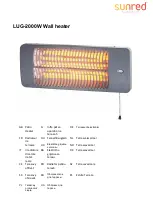
I pg 32
Turbotemp 125 Pool and Spa Heater Installation and User’s Guide
CONNECTING SINGLE-WALL STAINLESS STEEL VENT TO THE HEATER
Metallic:
1. Order an optional appliance adapter kit,
(Waterco offers optional appliance adapter kits, call
our Customer Service dept.):
- Part No. 6844320 150mm Flexible Double Wall Metal Duct Exhaust Kit
2. Remove the outside vent cover.
3. Install the Appliance Adapter in the Vent Body of the heater (located under the outside Vent
Cover). Before connecting the Appliance Adapter to the Vent Body, wet a clean cloth or
paper towel with isopropyl alcohol (rubbing alcohol) and vigorously wipe the socket of the
Vent Body. Immediately wipe the cleaned surfaces dry with a clean cloth or paper towel.
Repeat for the exterior of the heater end of the Appliance Adapter. Attach the appliance
adapter to the vent body using the adhesive specified by the vent manufacturer, following
the vent manufacturer’s instructions.
Risk of carbon monoxide poisoning if adapter is improperly attached.
Mechanical
connections (such as screws) can cause cracking and leaks in the adapter. Do
NOT
drill
holes or use screws to connect the appliance adapter to the heater vent body.
Attach with manufacturer’s specified adhesive.
!
WARNING
Risk of fire or asphyxiation if vent is not assembled according to manufacturer’s
instructions or if vent parts from different manufacturers are mixed.
Vent parts
from different manufacturers ARE NOT interchangeable. Mixing parts from more than
one manufacturer may cause leaks or damage to vent. When installing a vent, pick one
manufacturer and be sure that all vent parts come from that manufacturer and are specified
by the manufacturer for your system. Follow manufacturer’s instructions and local code
requirements carefully during assembly and installation.
!
WARNING
4. Install vent pipe so that it can expand and contract freely as the temperature changes.
Support the vent pipe according to applicable codes and vent manufacturer’s instructions.
Pipe support must allow the vent pipe free movement out and back, from side to side,
or up and down as necessary, without putting a strain on the heater or vent body. It is
recommended to slope the horizontal pipe down to condensate trap at least 2 cm/M (1/4
in per foot). Install “Approved” condensate drains at low points where condensate might
collect. Plumb condensate drains to a drain through hard piping or high-temperature tubing
such as silicone rubber or EPDM rubber – do not use vinyl or other low temperature tubing.
Follow drain manufacturer’s installation instructions.
5. Use an “Approved” firestop for floor and ceiling penetrations. Use an “Approved” thimble
for wall penetrations. Use an “Approved” roof flashing, roof jack, or roof thimble for all roof
penetrations. Do not fill the space around the vent (that is, the clear air space in the thimble
or firestop) with insulation. The roof opening must be located so the vent is vertical.
6.
Vent Termination – Vertical
(See Figures 26, 27, and 28) for height of vent termination above
the roof. Use an “Approved” vent terminal specified by local and national codes and your
manufacturer’s instructions. A roof termination must be vertical.
7. Make sure entire installation is sealed according to approved standard.
8.
Vent Termination – Horizontal
The terminal must be located (See Figure 26):
• at least 76 mm (3 in) and at most 304 mm (12 in) out from the wall (see Figure 26, page 22),
following the vent manufacturer’s instructions
• at least 304 mm (12 in) above finished grade or the normally expected snow accumulation
level, whichever is higher.
• at least 1.2 M (4 ft) below or horizontally from, or 0.3 M (1 ft) above, any doors or windows
or gravity air inlet to a building.
• at least 0.9 M (3 ft) above any forced air inlet located within 3 M (10 ft).
• at least 1.2 M (4 ft) horizontally from electric meters, gas meters, regulators and relief
equipment.
• at least 2.1M (7 ft) above grade adjacent to walkways or similar traffic areas. The terminal
must be located (See Figure 26):
• at least 3.3M (10 ft) from any opening into a building.
• at least 0.3 M (12 in) above finished grade or the normally expected snow accumulation
level, whichever is higher.
• at least 1.2 M (4 ft) horizontally from electric meters, gas meters, regulators and relief equipment
• at least 2.1 M (7 ft) above grade adjacent to walkways or similar traffic areas.
Outlet Air
Opening
Inlet Air
Opening
Chimney or Gas Vent
Vent Cap and
Riser Furnished
by Installer
Side
Wall Vent
by Installer
Side
Wall Vent
Heater
Outlet Air Opening
Inlet Air Opening
0.3 (1 in) Min.
1.2 M (4 in) Min.
1.2 M (4 in) Min.
1.2 M (4 in) Min.
7.6 cm (3 in) minimum clearance if
r
horizontal distance to
exhaust opening is less
than 3.3 M (10 ft).
Forced Air
Inlet
Vent
Termination
0.3 M (1 in) Minimum
above snow or
finished grade
(whichever is
higher)
At least 2.1 M (7 in)
above grade
adjacent
to public
walkways
Vent
Termination
Vent
Termination
Gas Meter
Max. 304 mm (12 in)
Min. 76 mm (3 in)
1.2 M
(4 in)
Min.
Figure 27.
Figure 26.
Figure 28.














































